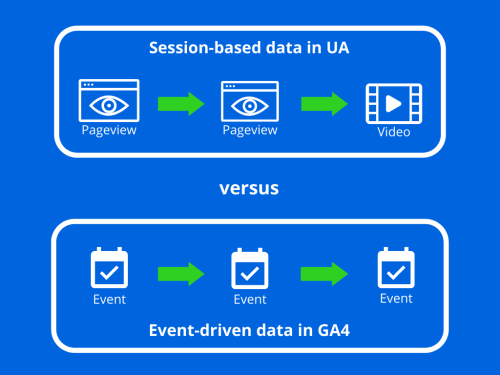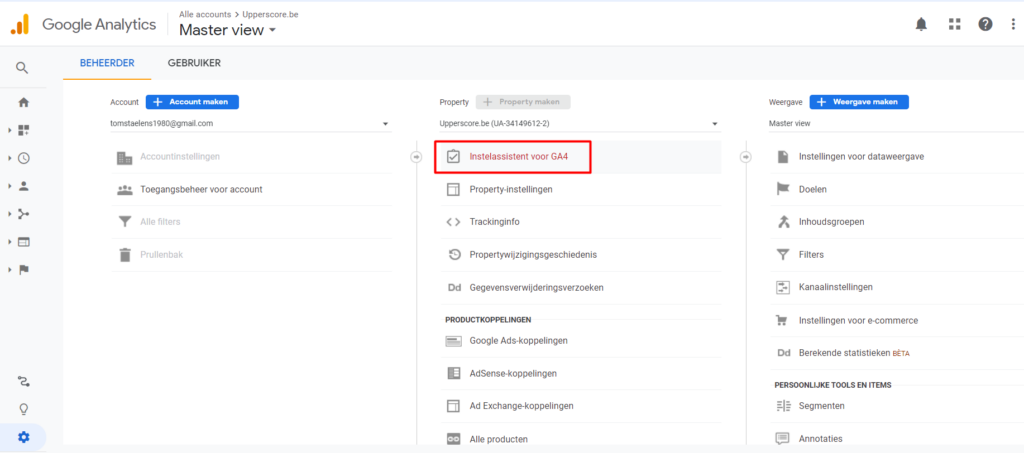Is there life after Universal Analytics with GA4?
In March 2022, Google made many marketing departments shake to their foundations. We saw it coming for quite some time, but in the meantime the end of Universal Analytics was officially announced. July 1, 2023, is the day that no more data will enter Universal Analytics. Is there life after Universal Analytics? Absolutely! But it will look completely different with GA4. How? You can find it here!
The end of Universal Analytics
You could already find Google Analytics 4 (GA4) for a while in Google Analytics. So it is not a complete surprise that Universal Analytics (the current version of Google Analytics) ceases to exist. After July 1, 2023, data will still be available for at least 6 months in your Universal Analytics property (until July 2024) for consultation only. So no new data will enter the system.
This ending point applies to every company that works with Universal Analytics. Even small businesses will have to migrate to GA4 if they want to keep receiving and analyzing their website data. But not just the migration to GA4 will be challenging. Also, the big differences between GA4 reports and Google Analytics reports, including the steep learning curve that goes with it, will be a challenge.
What changes in GA4
We summarize the main changes to the new GA4 property.
App and website traffic in one place
GA4 was brought to life to respond to an increasingly complex customer journey. In Universal Analytics, you needed to create two different properties for app and website traffic. GA4 gives you the possibility to link this data and create a data stream. So you get a much better idea of how a person interacts with your brand over different platforms.
Events instead of sessions
The data structure in GA4 revolves no longer around sessions, but around events. A page view will no longer be registered as such in GA4 but as an event. Also, scroll depth will be registered as an event. This new data structure will have a big impact on other metrics as well.


Today, we still use bounce rate to make statements about engagement. However, bounce rate is linked to sessions. So together with the sessions, we have to say goodbye to the bounce rate as well. It is still important to measure engagement, of course. But that will happen with ‘Engaged Sessions’. These are sessions with a certain form of engagement. GA4 will measure this in 3 ways.
- Two or more page views
- Your website or app has been running for at least 10 minutes at the forefront.
- A conversion was activated. Conversions are the same as goals in UA. So you define them yourself.
The sum of these 3 is the number of engaged sessions. No doubt that some new statistics will be introduced as well.
Cookies
During the past months, Google was under fire multiple times because of their privacy policies. In Austria and France, judges already prohibited Google Analytics. Apart from these specific cases, there is a general trend of 3rd party cookies being blocked by browsers more and more.
GA4 is Google’s answer to these events. They want to respond to and anticipate it with machine learning. Google will fill in missing data with AI so that you still have the necessary data to optimize your customer journey and customer experience over different platforms.
Next to this, it will be possible to submit a data removal request. This data will also be completed by AI and machine learning. This is a big step forward to guarantee the privacy of your visitors.
Interface and reports
Once you install and open GA4, you will notice that you get to see a whole new interface. As we said, a lot of metrics will be gone, but also a big part of standard reports will not be available. The advantage of this new way of reporting is that the different steps of the customer journey will be visualised way better.
Migration from Universal Analytics to GA4
July 2023 might seem far away, but we recommend taking action already in the short term and installing your GA4 property before July 2022. To draw conclusions from data and measure growth, a lot of companies compare their data today with their data from a year ago.
If you want to keep doing this with GA4, it is essential to start migrating to GA4 already. This ensures that you start getting data into a GA4 property in July 2022. Data from Universal Analytics will not be imported into GA4. So you have to start from scratch.
If you have GA4 in place by July 2022, you will have a solid basis by July 2023 when data collection will end in Universal Analytics. During this period, you can keep running both properties (UA and GA4) next to each other and set up the necessary elements for the switch like reports and audiences. Moreover, this gives you time to get used to the new GA4 interface and get some training.
The big difference between UA and GA4 causes a big learning curve. Make sure to check Google Skillshop to learn more about the new GA4 property or ask us all your questions!
Where can I find GA4 in Google Analytics
Google Analytics already has the option to set up your GA4 property for several months. You can find it under ‘admin’ and then you can choose ‘GA4 setup assistant’ (in the property column). Google will guide you through the process.
Unfortunately, there is no button to transport your data from Universal Analytics into GA4. Because of the difference in the data structure (event vs session-based), this is not possible and your new GA4 property is empty. However, if you set up GA4 before July 2022, you will have a nice collection of historical data by July 2023.

Alternatives for Google Analytics
The switch to GA4 can trigger an important question: should we keep using Google Analytics?
On the one hand, we notice that the privacy question is becoming a bigger problem because there is no clear law about using European data in US data centra. For an American company like Google, this could become a challenge.
On the other hand, you have to put time and effort into setting up GA4 and learning how to use it. So it could be the right moment to change to a different platform.
That is why we would like to share these European alternatives for Google Analytics.
Matomo
- Matomo’s reporting is very similar to Universal Analytics. Also the interface is very similar.
- It is suited for smaller businesses with less data
- European company. So in line with European privacy laws, since the data does not have to pass through the US
- No sampling, so the raw data is used
Piwik Pro
- A beautiful range of metrics
- Suited for big companies with a lot of data that want to scale
- European company. So in line with European privacy laws, since the data does not have to pass through the US
- No sampling, so the raw data is used
Whether you keep Google Analytics and migrate to GA4 or whether you want to change to one of the alternatives, it is clear that every marketeer should prepare for July 1, 2023. Because after that date, Universal Analytics inevitably disappears.
Need help with your migration to GA4?
Please let us know. We will be happy to help you on your way!






